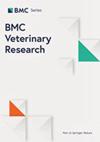KC-like chemokine as a biomarker of sepsis in dogs with pyometra
IF 2.3
2区 农林科学
Q1 VETERINARY SCIENCES
引用次数: 0
Abstract
Sepsis, defined as a dysregulated inflammatory response to infection inducing organ dysfunction, is a common cause of mortality in both humans and animals. Early detection and treatment is essential for survival, but accurate diagnosis is challenging due to the lack of specific biomarkers for sepsis. This study explored the potential of the keratinocyte-derived chemokine (KC)-like protein in dogs as a biomarker of sepsis in dogs with bacterial uterine infection (pyometra). The aim was to compare KC-like concentrations in dogs with pyometra with or without sepsis and to assess associations between KC-like and clinical variables, including days of hospitalization as an outcome. A mouse KC ELISA was validated and used to determine the concentrations of KC-like in serum from 34 dogs with pyometra and 18 healthy controls. Dogs with pyometra were classified as having sepsis based on two different criteria for systemic inflammatory response syndrome (SIRS), resulting in 74% and 30% sepsis-positive, respectively. The concentration of KC-like protein was higher in pyometra dogs with sepsis than in pyometra dogs without sepsis (p < 0.05) and in healthy controls (p < 0.0001) when using either of the two SIRS criteria. Moreover, KC-like was slightly increased in dogs with pyometra without sepsis compared with healthy controls when using the more stringent SIRS criteria (p < 0.05). Analyses of all dogs showed that KC-like concentrations correlated positively with hospitalization days, C-reactive protein (CRP) concentrations, white blood cells, and percentage of band neutrophils; however, KC-like correlated negatively with hemoglobin and did not correlate with circulating creatinine. Our results suggest that circulating KC-like protein increases in dogs with sepsis in pyometra and that KC-like is associated with more severe clinical illness. These findings support a potential role of KC-like as a biomarker of sepsis; however, the true identity of KC-like in dogs has yet to be uncovered.作为脓毒症犬败血症生物标志物的 KC 样趋化因子
败血症被定义为对感染的炎症反应失调而导致器官功能障碍,是人类和动物死亡的常见原因。早期发现和治疗对生存至关重要,但由于缺乏败血症的特异性生物标志物,准确诊断具有挑战性。本研究探讨了狗体内角质细胞衍生趋化因子(KC)样蛋白作为细菌性子宫感染(脓毒血症)狗败血症生物标志物的潜力。该研究旨在比较患有或未患有败血症的子宫脓肿犬体内的 KC 样蛋白浓度,并评估 KC 样蛋白与临床变量(包括作为结果的住院天数)之间的关联。我们对小鼠 KC 酶联免疫吸附试验进行了验证,并使用该试验测定了 34 只患子宫脓肿的狗和 18 只健康对照组狗血清中的 KC 样浓度。根据两种不同的全身炎症反应综合征(SIRS)标准将患有脓毒症的狗分类,结果脓毒症阳性率分别为 74% 和 30%。采用两种 SIRS 标准中的任何一种,患有败血症的脓毒症犬的 KC 样蛋白浓度高于未患败血症的脓毒症犬(P < 0.05)和健康对照组(P < 0.0001)。此外,在使用更严格的 SIRS 标准时,与健康对照组相比,无败血症的脓毒症患犬的 KC 样性略有增加(p < 0.05)。对所有犬进行的分析表明,KC-like 浓度与住院天数、C 反应蛋白 (CRP) 浓度、白细胞和带状中性粒细胞百分比呈正相关;但是,KC-like 与血红蛋白呈负相关,与循环肌酐无相关性。我们的研究结果表明,脓毒症犬的循环 KC 样蛋白会增加,而且 KC 样蛋白与更严重的临床疾病相关。这些研究结果支持 KC 样蛋白作为败血症生物标志物的潜在作用;然而,KC 样蛋白在犬体内的真实身份还有待揭开。
本文章由计算机程序翻译,如有差异,请以英文原文为准。
求助全文
约1分钟内获得全文
求助全文
来源期刊

BMC Veterinary Research
VETERINARY SCIENCES-
CiteScore
4.80
自引率
3.80%
发文量
420
审稿时长
3-6 weeks
期刊介绍:
BMC Veterinary Research is an open access, peer-reviewed journal that considers articles on all aspects of veterinary science and medicine, including the epidemiology, diagnosis, prevention and treatment of medical conditions of domestic, companion, farm and wild animals, as well as the biomedical processes that underlie their health.
 求助内容:
求助内容: 应助结果提醒方式:
应助结果提醒方式:


